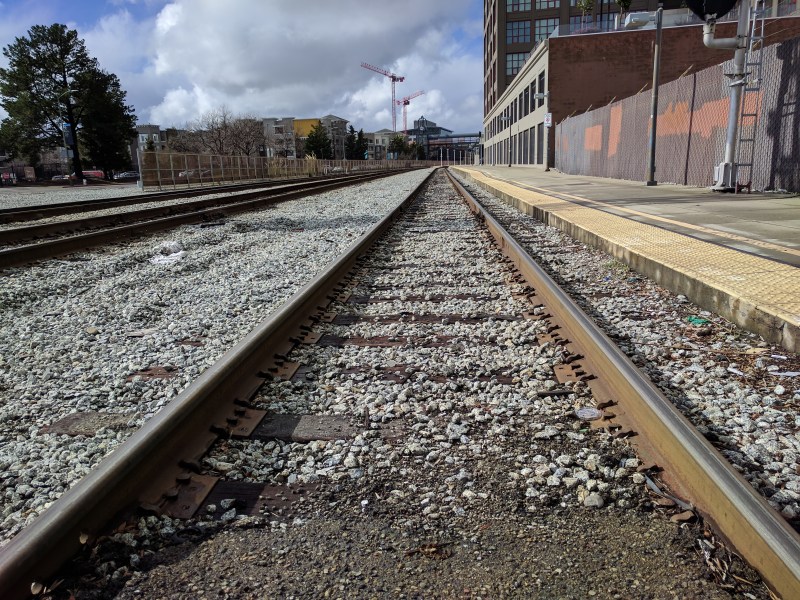"A bullet train that never leaves the Central Valley [emphasis added], but only shuttles between Bakersfield and Merced, may not be a 'train to nowhere,' but its value and potential would be greatly diminished," wrote the LA Times in an editorial about governor Newsom's announcement that he will focus primarily on the spine, rather than the ends, of California's High-Speed Rail project.
With all the confusion around HSR, and the endless repetition of the tiresome and fallacious "train to nowhere" meme, it's probably a good idea to reiterate that the high-speed train network California is designing and building uses the same wheel and track dimensions as the national rail network and California's commuter railroads.
High-speed rail is not some kind of rare unicorn that can never leave its cage. During early phases of HSR projects in other parts of the world, it is common to run hybrid operations--with high-speed trains slowing and running on conventional tracks. Likewise, California's HSR train, in one way or another, will leave the Central Valley, because they can run on existing tracks, pulled by existing Amtrak locomotives.
In fact, off-the-shelf HSR trains have already run to and from the Central Valley. Here's a picture of a German Intercity Express (ICE) High speed train, which is capable of running at around 190 mph, tootling along outside of Sacramento during a demonstration run back in the 1990s.
The two locomotives at the front are standard Amtrak diesel locomotives painted to match the rest of the train. The photo is from a publicity tour back when Amtrak was developing a higher-speed project between Boston and Washington (later branded 'Acela') that was to squeeze more speed out of existing tracks. Amtrak's Cascade service between Oregon and Washington also uses lightweight, HSR passenger cars pulled by diesel locomotives, so there's nothing unusual about running HSR rolling stock, in service, on Amtrak lines. New regulations from D.C. will make this kind of operation even simpler and more common in the future.
Now here's the same type of train as in the above photo, but on a dedicated HSR line in Germany, where it goes nearly 200 mph.
HSR is more about the tracks and infrastructure than the train. On a high-speed line there are electric wires overhead. A high speed train raises a pantograph, which is a collector that makes contact with a high-voltage wire, connecting the train directly to the grid.
Thus, the train is "plugged in" to 25,000 volts, which runs its incredibly powerful motors that, in conjunction with tracks that are built to a much higher standard, enable the train to go over 200 mph (and they've gone as fast as 357 mph in tests).
But that doesn't mean they can't also run at lower speeds on older, non-electrified lines, including the existing tracks in California.
In fact, running HSR trains on a mix of dedicated lines and older lines is how almost all HSR systems were and are developed around the world. There were regular TGV services in France that continued onto non-electrified lines, towed by a diesel, to reach smaller towns. Spain has dual-mode HSR services that can run on electric or diesel power without changing locomotives. Even the Eurostar high-speed service, which runs between Paris and London, used to decelerate in England and spend about half of its run on on slow, outdated infrastructure (running on third-rail power, in that somewhat unusual case). Every few years, as additional Eurostar HSR segments are completed, journey times are reduced, and ridership increases.
Here's a map of Amtrak's existing rail services between Sacramento, the Bay Area, and Merced and Bakersfield:
Merced, the city at the northern end of Newsom's planned Central Valley HSR spine, is already connected to Sacramento and Oakland, via the tracks in the lead image.
Amtrak already carries over a million passengers annually on the lines pictured above. Interlining HSR with the Altamont Commuter Express, to connect up San Jose, will also be possible.
It would be better if California could build the whole HSR system at once. But that was never possible, even under the best scenarios. Since Newsom is planning to continue engineering work on the Los Angeles and San Francisco parts of the system, when the political winds shift again, construction of the next phases will continue, just as it did on the HSR lines overseas.
If HSR follows this pattern of incremental construction, Californians will eventually experience trains running on smooth tracks, with barely any cabin noise, at 220-250 mph, from Bakersfield to Merced. They'll feel a slight bump during the Merced stop as a diesel locomotive is coupled to the front. And they'll see the stark contrast as their train continues at "normal" speeds on the state's current bumpy, slow and aged tracks to Sacramento, San Jose, and the Bay Area.
After that, the question they'll ask is: when can we finish building true HSR all the way to San Jose, San Francisco, Los Angeles, Sacramento, San Diego, Las Vegas and beyond?






